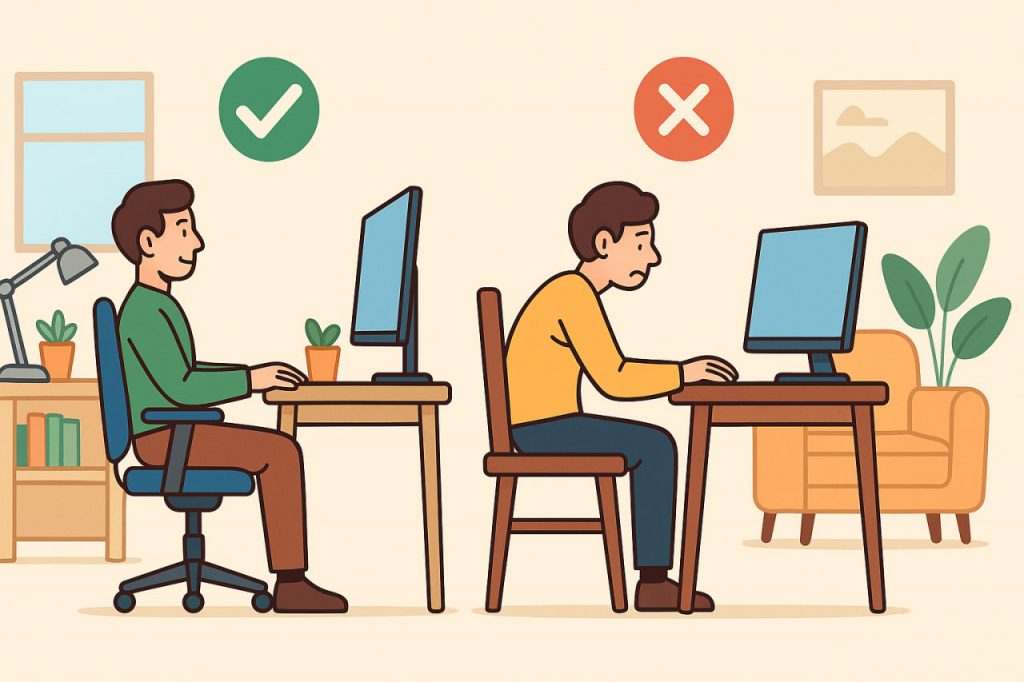Sitting is something we do for hours every day — at work, during meals, and while relaxing. However, few people realize that choosing the wrong chair or sitting incorrectly can harm health over time. Back pain, poor posture, headaches, and even breathing problems often start with an uncomfortable or ergonomically incorrect chair. Knowing how to choose the right seat and maintain proper posture can greatly improve comfort, focus, and long-term well-being.
Why the Right Chair Matters
Modern lifestyles involve long hours of sitting — often more than 8–10 hours per day. When we sit incorrectly, we put excessive pressure on the spine, hips, and neck, leading to muscle tension, joint strain, and circulation problems.
A properly chosen chair can:
- Support the natural curvature of the spine.
- Improve blood circulation and reduce leg swelling.
- Decrease neck and shoulder strain.
- Enhance concentration and productivity.
In contrast, poor seating positions can lead to chronic discomfort, muscle imbalance, and even spinal deformities.
Key Features of a Good Chair
Whether it’s for work, study, or relaxation, a well-designed chair should meet several ergonomic standards:
- Adjustable height: The feet should rest flat on the floor, with knees at a 90° angle.
- Lumbar support: A slight curve in the lower back area helps maintain proper spinal alignment.
- Seat depth and width: There should be a small gap (2–3 cm) between the seat’s edge and the back of your knees.
- Backrest angle: Should allow reclining slightly (about 100–110°) to reduce spinal pressure.
- Armrests: They should support the elbows lightly, keeping shoulders relaxed.
- Material: Breathable fabrics or mesh are preferable to avoid overheating during long sitting periods.
Correct Sitting Posture
Even with a perfect chair, poor posture can still cause problems. To sit properly:
- Keep feet flat on the floor or on a footrest.
- Align hips and knees at a 90° angle.
- Sit back fully against the chair’s backrest for support.
- Keep shoulders relaxed and head aligned with the spine.
- Avoid crossing legs for long periods — it restricts blood flow.
Taking short breaks every 30–60 minutes to stand, stretch, or walk is also essential for spinal health and circulation.
Choosing the Right Chair for Different Needs
- Office work: Ergonomic office chairs with adjustable lumbar support, armrests, and headrests are ideal. Models like “mesh back chairs” allow airflow and reduce sweating during long use.
- Gaming or creative work: Chairs with additional neck and lower-back cushions help maintain posture during extended sessions.
- Dining chairs: Choose stable chairs with moderate back support; avoid soft, overly low seats.
- For children and students: The chair should grow with the child — adjustable height and backrest are crucial to prevent scoliosis.
- For relaxation: Recliners or rocking chairs should still maintain back alignment and offer neck support.
The Role of the Desk and Surroundings
The perfect chair works best when paired with a properly arranged workspace.
- The table height should align with elbow level.
- The monitor should be at eye level, about 50–70 cm away.
- Lighting should come from the side to avoid screen glare and eye strain.
Maintaining an ergonomic environment minimizes fatigue and improves focus during work or study.
Common Mistakes to Avoid
- Sitting on soft couches for long periods — they cause the spine to curve unnaturally.
- Leaning forward excessively while working on a laptop.
- Ignoring regular movement breaks.
- Using chairs that are too high or too low, causing leg pressure or neck strain.
Additional Tips for Comfort and Health
- Use a small pillow or lumbar roll for extra lower-back support.
- Alternate between sitting and standing using height-adjustable desks.
- Stretch your neck, shoulders, and lower back regularly.
- Invest in quality, not just design — a good chair lasts years and prevents medical costs later.
Interesting Facts
- Sitting burns only about 60–70 calories per hour, compared to 150–200 when standing.
- People who sit for over 8 hours daily have a higher risk of cardiovascular disease, even if they exercise.
- The term “ergonomics” comes from Greek — ergon (work) and nomos (law) — meaning “laws of work efficiency.”
- NASA studies show that a reclined position of 100–110° puts the least stress on the spine.
Glossary
- Ergonomics — the science of designing tools and environments for comfort, safety, and efficiency.
- Lumbar support — the part of a chair that supports the lower back.
- Posture — the way a person holds their body when sitting or standing.
- Circulation — the continuous movement of blood through the body.
- Reclining angle — the backward tilt of the chair’s backrest that relieves pressure on the spine.


